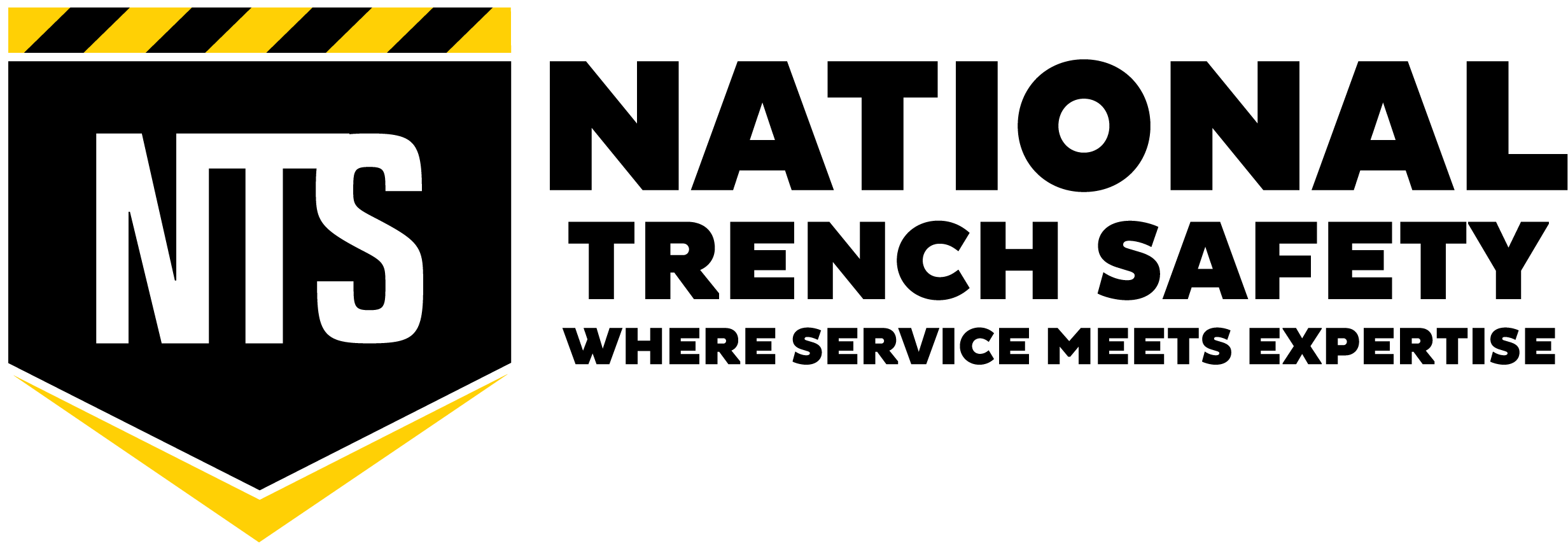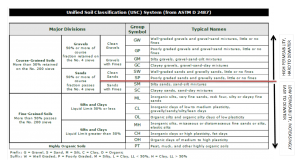Water has an undeniable impact on the selection of shoring systems. The presence of water can have a significant impact on soils, which is why water is commonly mentioned in most manufacturers ‘ tabulated data. The water table tells the contractor where to expect water, it’s based on soil sampling on a specific job site, which can be used in protective system selection. Depending upon the concentration of water, the contractor may elect to pursue a dewatering plan to mitigate the impact of the water. In some areas, dewatering occurs on almost every shoring project of any material depth as it’s needed to promote safe and efficient excavation. While a dewatering plan is typically completely separate from a shoring plan, the two plans can be critical to a project’s success. Based upon experience across many projects, I’ve provided a few important topics that contractors should consider when a dewatering plan may be needed on a shoring project:
Water Table Conditions
As a general rule, pipeline and foundation design engineers require that the level of the water table inside the shoring system be maintained at least two feet below the base grade. When a contractor is working with concrete structures the base grade is 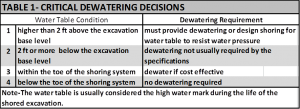 considered to be the surface the concrete is being placed on, while for a pipeline the base grade is considered to be the lowest level of the bedding material that the pipe is placed on (which is usually 6-in to 12-in below the bottom of the pipe).
considered to be the surface the concrete is being placed on, while for a pipeline the base grade is considered to be the lowest level of the bedding material that the pipe is placed on (which is usually 6-in to 12-in below the bottom of the pipe).
Any time the anticipated high water table is 2 feet below the base structure, dewatering is not typically required. In the event, the shoring system uses the soils below the bottom of the excavation for support (a common example would be sheet piles driven below 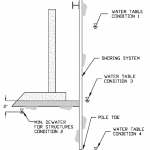 grade), the water level below 2 feet can adversely affect the design.
grade), the water level below 2 feet can adversely affect the design.
Table 1 provides a high-level chart of the different possible water conditions and dewatering requirements. Walking through the various conditions:
- Condition 1 typically requires the most extensive planning for shoring systems because the shoring system not only needs to support the soil, but it must also be strong enough to support the water, which is typically done by providing continuous “toe” to cut off the water. With standard trench boxes or any other system that stops at the bottom of the excavation, the water will easily run under the bottom of the protective system. The counteraction to prevent this water flow would be to dewater the site.
- Condition 2 would be the scenario previously discussed where water is 2 ft below grade and the water doesn’t have a substantial impact upon the shoring system.
- Condition 3 represents a scenario where water is somewhere within the pile toe. This scenario typically will result in longer sheet piles or H-pile toes in pile and lagging systems. The cost of dewatering to condition 4 has to be compared to the cost of additional pile purchase and driving.
- Condition 4 represents a scenario where water is 2 feet below the toe of the system and in this scenario, no dewatering would be required.
It’s also important to understand that almost all manufactured shoring systems like trench shields, modular aluminum shields, and hydraulic vertical shores are depth rated for condition 2 of the chart. When using these systems this means that no water is allowed to be backed up behind the respective protective system.
Soil Type, Dewatering, and Shoring
Cohesive and non-cohesive soils react differently, and in most cases when dewatering and shoring systems are applied, the reactions are opposites. For this reason, among others, it is extremely important to determine the water conditions prior to selecting a shoring system. Once the commitment has been made to dewater to a specified level it cannot be changed without changing the shoring requirements. When planning a project, the shoring system is often a cost that can be quantified and predicted, while dewatering costs can be harder to predict and can change based on seasons and or the soils encountered on linear projects.
Clay soils are typically easier to dewater than non-cohesive soils, however, clay soils can exert higher loads on the shoring because they contain water in the particles. Removal of excess water in saturated clay soil can substantially reduce the shoring 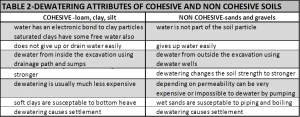 cost; however, since clay soils do not release water easily, it can take a long period of time to force water out. The water-bound with the clay particles will not flow out and can only be removed by drying or some other chemical or wicking process (both are typically very expensive to perform). On the positive side, dewatering in cohesive soils can usually be accomplished from inside the excavation. Additionally, when compared with non-cohesive soil, interior dewatering requires far less pumping, whereas dewatering in non-cohesive soils would require wells drilled outside the excavation, deeper than the excavation, with high volume, pumping, and handling costs.
cost; however, since clay soils do not release water easily, it can take a long period of time to force water out. The water-bound with the clay particles will not flow out and can only be removed by drying or some other chemical or wicking process (both are typically very expensive to perform). On the positive side, dewatering in cohesive soils can usually be accomplished from inside the excavation. Additionally, when compared with non-cohesive soil, interior dewatering requires far less pumping, whereas dewatering in non-cohesive soils would require wells drilled outside the excavation, deeper than the excavation, with high volume, pumping, and handling costs.
Non-cohesive soils with high water tables almost always require some sort of continuous sheeting/shoring system that extends below the bottom of the excavation to cut off the water. If the site has clay layers below the bottom, the sheeting can press through those layers to effectively cut the water off. If non-cohesive layers persist below grade instead of the aforementioned cohesive soil, the water will still go around the bottom of the sheeting and require additional pumping from inside the excavation.
The soil report for the project is critical to predicting soil type and dewatering conditions. The contractor should review the bore logs to determine the soil type and the water table at the time of drilling. The Unified Soil Classification System (USC) group symbols will be located in the description. Sands and gravels with finer composition (“GM, GC” and “SM, SC”) are going to be easier to dewater than clean sands because the fines decrease the permeability. The permeability and the design water table are usually included in the text of the soil report.
Review
It cannot be emphasized enough, that on projects with high water tables, a good dewatering expert and a good soil engineer should be consulted. It’s often preferable to consult with these professionals in the bidding phase so that scenarios can be considered and the costs factored into the project bid package. From past experience, dewatering contractors typically have very good dewatering engineers since they specialize in dewatering and can draw upon extensive past experience. The same is also true for shoring design engineers. There’s an inherent benefit to selecting partners that specialize and have routine, recurring exposure to the topics to offer advice with these complex scenarios.
When comparing dewatering and shoring, in my experience water problems have usually caused more headaches for contractors than shoring systems on a given project. On less intensive dewatering projects, the contractor’s estimator and a shoring engineer can usually reach a reasonable dewatering decision, however, water and shoring are two completely separate issues. The responsibility for getting it right, and the risk if it goes wrong, always rests with the contractor. For this reason, when NTS’s engineering group provides engineering services, we only perform shoring system design and refer the contractor to a dewatering specialist.
